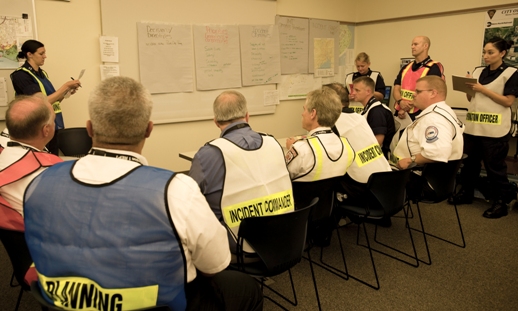Emergency Management Positions

BRIDGEPORT, CT - Coast Guard personnel participate in an Area Maritime Security Training and Exercise Program, June 13, 2013, in Bridgeport, Conn. The exercise allows Coast Guard members to collaborate with several local, state and government agencies and to understand the role each group is responsible for during major incidents. (U.S. Coast Guard photo by Petty Officer 3rd Class Ali Flockerzi)
Emergency Mgt. (EM) and Incident Command System (ICS) Positions
Within EM, the Auxiliary has appointed positions like District Staff Officer for Emergency Management (DSO-EM) and Assistant District Staff Officers for Emergency Management (ADSO-EM) that facilitate specific EM programs at the District level. One such task is the Agency Representative (ARep), who works in a local or county Emergency Operations Center (EOC) and represents the Coast Guard Sector. These positions are available to Auxiliarists, provided the member has requisite entry-level instruction and minimal training and is recommended by Sector Command personnel.
The Emergency Management and Disaster Response Directorate (Q) is on the National Staff level. You are on the Q’s website. Q provides national policy directives for EM functions and, when requested, support to Auxiliary District EM tactical operations. Several staff positions are available on the national level in the Q Directorate. Some staff functions do not require specific EM experience or advanced qualifications. For an Auxiliary member interested in an EM career path, a staff position may provide a tremendous opportunity to grow in the field and support the mission.
What are ICS positions? One position is the ARep. During a significant incident, the ARep sits at an EOC or remote location and is the Coast Guard’s Sector representative. For example, an EOC Incident Commander (IC) may request a boat or helicopter for support and will ask if one is available from the Coast Guard. That request would be routed via the ARep, sending a message to the Incident Management Team (IMT) at the Sector. The ability to meet that request for a resource would then be transmitted back to the EOC via the ARep. Conversely, the Coast Guard Sector IMT may need information from the County, such as the status of bridge openings. Again, the ARep would be that conduit for the communication.
ICS positions are staffed by the people who manage the response to an incident. On the top of the organization would be an Incident Commander or, if the situation is large and complex, an Area Commander may exist. ICS has a comprehensive command structure from the IC to the Command Staff, General Staff, and Unit Leaders. Many but not all ICS positions require signoffs of Personal Qualification Standards (PQS). Some advanced ICS positions require a PQS signoff and a Letter of Designation from the Coast Guard Command.